Learning how to write dialogue can be tough for some without the right guidance.
This is why we started Fundamentals of Fiction & Story in the first place. We wanted to give writers the skills and knowledge they needed to take an idea and turn it into a bestselling novel (and even potentially a full-time career).
But unless you plan on writing a textbook, you must learn how to properly create dialogue—and use it correctly because yes, there is a wrong way to present dialogue (and we’ll get into that later).
Without effective dialogue, even the best plot or book ideas will fall flat. Your efforts for successfully publishing a book that reads well will be ineffective. Writing well is the cornerstone of marketing your book. Ultimately, your reader’s reviews of your book will hold weight.
Because if the dialogue is bad… Readers will put the book down (because the dialogue is often what readers pay the most attention to).
But if you’re not sure how to write dialogue in a way that is not

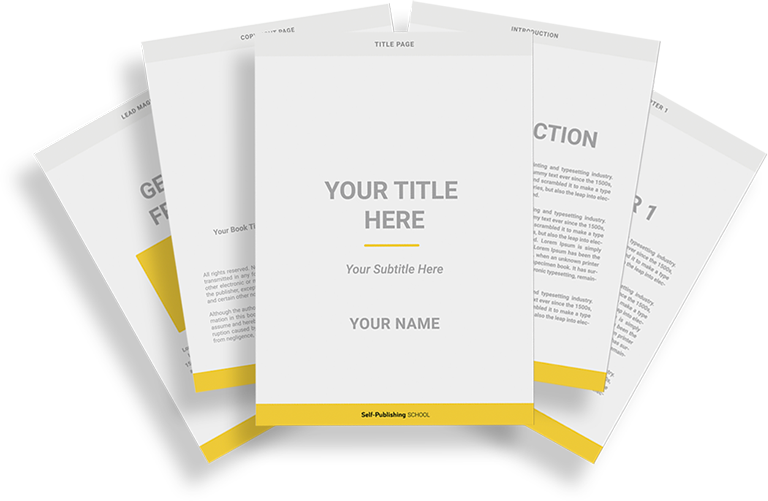
Book Outline Generator
Choose your Fiction or Nonfiction book type below to get your free chapter by chapter outline!
Book Outline Generator
Enter your details below and get your pre-formatted outline in your inbox and start writing today!
CONGRATULATIONS
Thanks for submitting! Check your email for your book outline template.
In the meantime, check out our Book Outline Challenge.
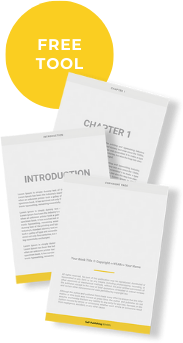
You can’t write a book without dialogue—and you can’t write a good book without good dialogue (even if you’re writing a nonfiction book!).
In this post, we’ll cover everything you need to know about how to write dialogue, including dialogue format, dialogue punctuation, examples of dialogue with grammar, and common dialogue mistakes to avoid.
We’ll also cover, in detail, how to write realistic dialogue.
Here’s what to know about writing dialogue:
- Dialogue Rules
- Format & Punctuation
- Examples
- Tips for Dialogue
- Say the dialogue out loud
- Cut small talk when writing dialogue
- Keep your dialogue brief and impactful
- Give each character a unique voice
- Add world-appropriate slang
- Be consistent with the characters’ voices
- Remember who they’re speaking to
- Avoid long dialogue paragraphs
- Cut out greetings
- Show who your character is
- Mistakes to avoid
*click to jump to that section
Ready to learn what makes great dialogue? Let’s get started.
Basic Dialogue Rules All Writers Should Follow
Before we get into the actual formatting and styles of writing dialogue (along with some tips for making sure it’s good dialogue), let’s go over some of the common and universal rules for writing dialogue in any book genre.
Here are the main rules for writing dialogue:
- Each speaker gets a new paragraph. Every time someone speaks, you show this by creating a new paragraph. Yes, even if your characters are only saying one word, they get new paragraphs.
- Each paragraph is indented. The only exception for this is if it’s the start of a chapter or after a scene break, where the first line is never indented, including with dialogue.
- Punctuation for what’s said goes inside the quotation marks. Any time the punctuation is a part of the person speaking, they go inside the quotes so the reader knows how the dialogue is said.
- Long speeches with several paragraphs don’t have end quotations. You’ll see more on this below, but overall, if one character is speaking for so long they have separate paragraphs, the quotation marks on the end are removed, but you start the next paragraph with them.
- Use single quotes if the person speaking is quoting someone else. If you have a character who says, “Man, don’t you love it when girls say, ‘I’m fine’?”, the single quotes indicate what someone else says.
- Skip the small talk and focus on important information only. Unless that small talk is relevant for character development, skip it and get to the point, this isn’t real life and will actually feel more fake if you have too much.
Dialogue Punctuation and Format
When it comes to book formatting,
It’s not that it’s especially complicated, but there are many different types of dialogue and many different types of punctuation (including when to use a comma, quotes, and even em dashes) needed in order to properly format it.
Therefore, it’s easy to get confused or forget which format you should use for which line of dialogue.
The
In order to fully understand how to format dialogue, you have to know how to punctuate it properly, depending on the form you’re using.
The one thing most writers get wrong when they’re first starting out is proper dialogue format.
Sure, you could leave that up to the editor, but the more work for your editor, the more expensive they’ll be.
Plus, it’s important that, as serious writers and future authors, you know how to punctuate dialogue no matter what.
That also means editors will be able to focus on more complex edits instead of just punctuation.
Dialogue punctuation is complex and takes some time to learn, understand, and master.
While we go into more depth with dialogue in our Fundamentals of Fiction program, here are some dialogue examples of each and how you would punctuate them.
Dialogue Example 1: Single Line
Single lines of dialogue are among the easiest to write and remember. The punctuation for this dialogue is simple:
The quotations go on the outside of both the words and end-of-dialogue punctuation (in this case a period, but it’s the same for a comma, question mark, or exclamation point).
Example:
“You really shouldn’t have done that.”
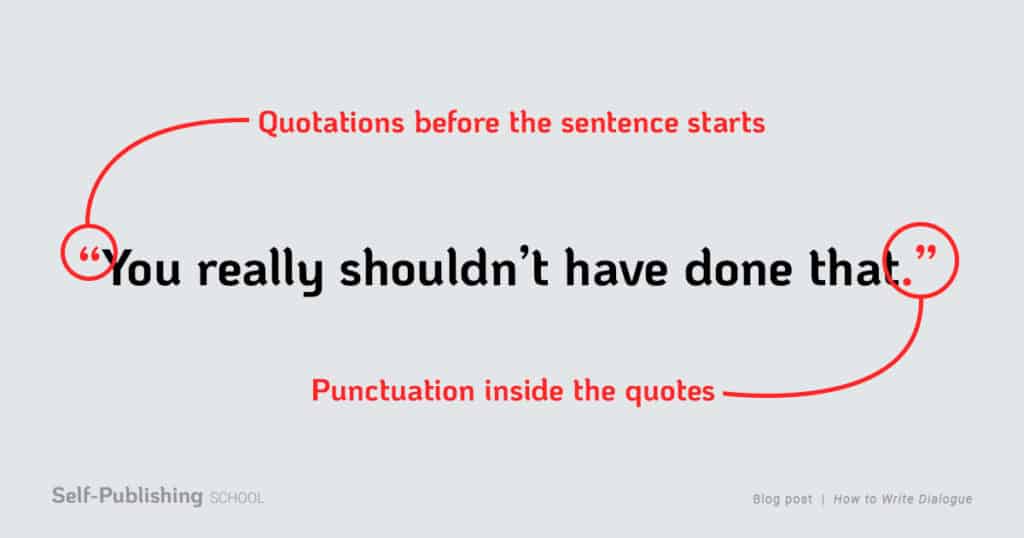
No matter what other punctuation you have, whether it’s a question mark or exclamation point, it will go on the inside of the quotations.
Dialogue Example 2: Single line with a dialogue tag
In this case, “tag” means dialogue tag.
A dialogue tag is anything that indicates which character spoke and describes how they spoke.
Here are some common examples of dialogue tags:
- He said
- She whispered
- They bellowed
- He hollered
- They sniped
- She huffed
- He cooed
- They responded
In the example below, you can see that the dialogue tag goes on the outside of the quotations, while the comma goes on the inside.
Example:
“You really shouldn’t have done that,” he whispered.
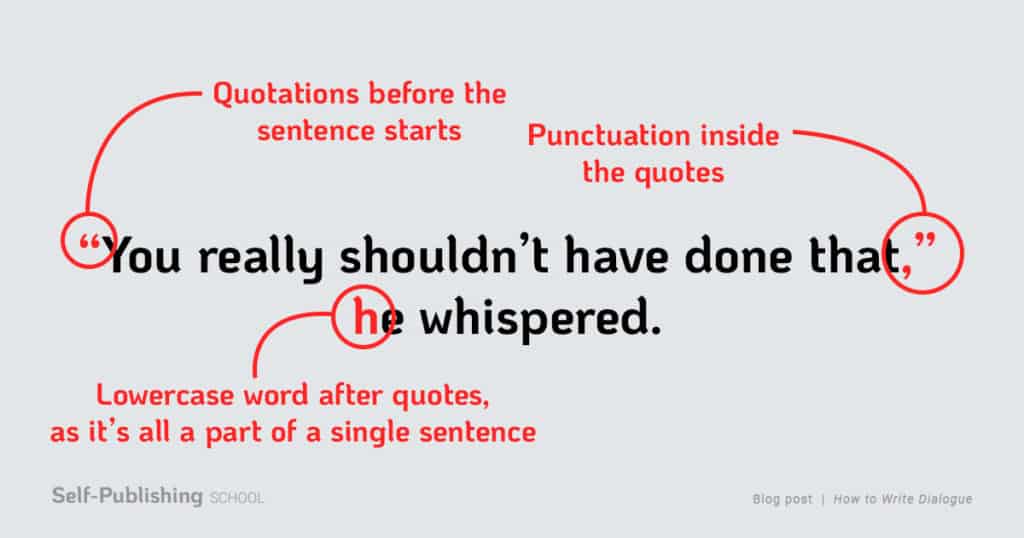
This is the case with any dialogue tags that are used. You can also see how this dialogue formatting works with different types of sentences and different dialogue tags.
Note that the tag, when following a comma within the quotation marks, is lowercase, as it’s a part of the overall sentence.
Dialogue Example 3: Questions
Because a question mark seems like the end of a sentence, it’s easy for most writers to get the format for questions when writing dialogue wrong.
But it’s actually pretty easy. Essentially, a question mark will be treated as a comma or period. What changes the formatting most is what follows the dialogue.
Example:
“Are you sure we have to leave that early?” she wondered aloud.
Here are some examples of writing questions in dialogue:
- “Will you ever stop being a child?” she asked.
- “What about that man over there?” he whispered, pointing in a old gentleman’s direction. “Doesn’t he look odd too?”
- “What’s the big deal, anyway?” she huffed.
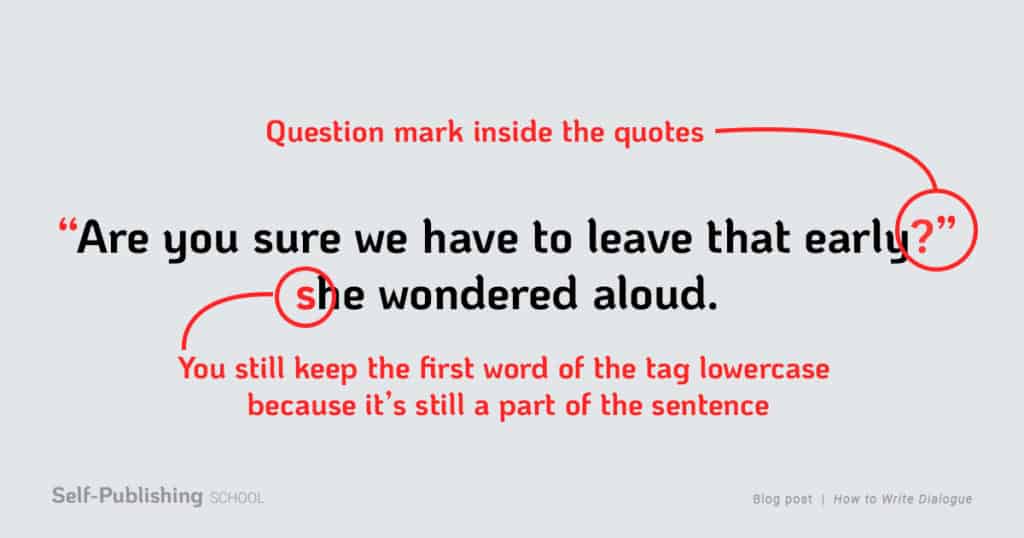
In this example above, you can see that if there is a dialogue tag, the question mark will act as a comma and you will then lowercase the first word in the dialogue tag (unless it’s a person’s name).
However, if there is simply an action after the question, the question mark acts as a period and you will then capitalize the first word in the next sentence.
Dialogue Example 4: Dialogue Tag, then single line
When it comes to formatting dialogue tags before your character speaks, it’s essentially the same as when they come after, except backward.
As you can see in the example above, the dialogue tag is in front, followed by a comma outside of the quotations. Then the quotations appear when the sentence starts with that sentence’s punctuation inside the quotations at the end.
Example:
He finally said, “Fine. Let’s just go for it.”
Here are a few more examples of this type of dialogue, as it’s very common:
- They hung their head and mumbled, “It’s fine if you don’t want me to come.”
- She huffed, “Well that’s just great, isn’t it?”
- He drew in a long breath and spoke, “I’m just not sure what to do anymore.”
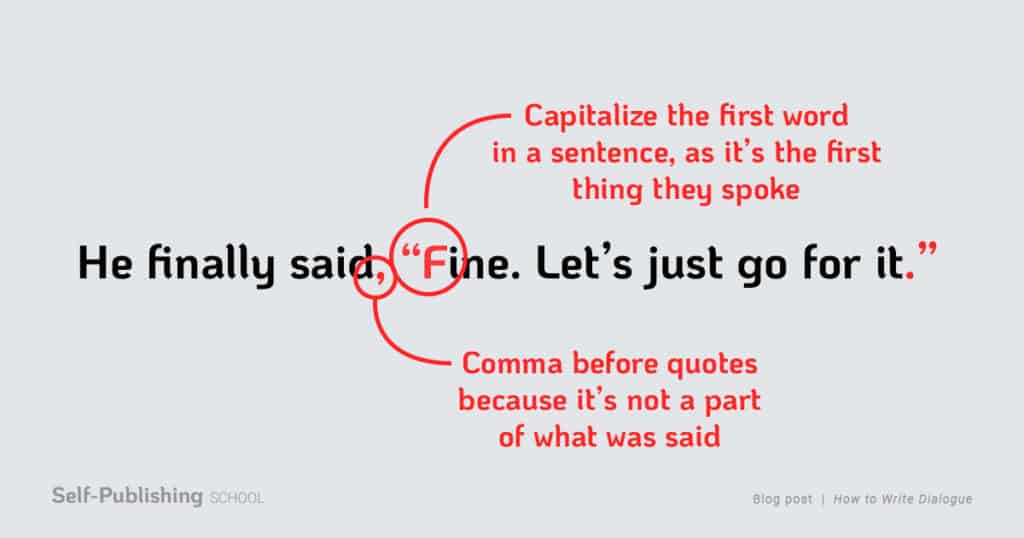
Dialogue Example 5: Body language description
There are a couple of different types of body language dialogue formats to learn.
Variation 1:
This is when the actions your character is taking come between lines of dialogue but after a sentence is complete. In real life, this would indicate someone pausing to complete the action.
Example:
“I don’t see what the big deal is.” She tossed a braid over her shoulder. “It’s not like she cared anyway.”
Here’s what this dialogue example looks like:
- “Are you sure we should go this weekend?” She shoved the curtain aside, sneering at the greying clouds. “It could be a mess out there.”
- “What’s the big deal, anyway?” He yanked the sheet from the envelope. “It’s not like you cared for her all that much.”
- “Let’s go to the moon!” She twirled, her pale pink dress lifting around her. “We could make it, I know we could.”
Below is a detailed explanation of how you would format this type of dialogue:
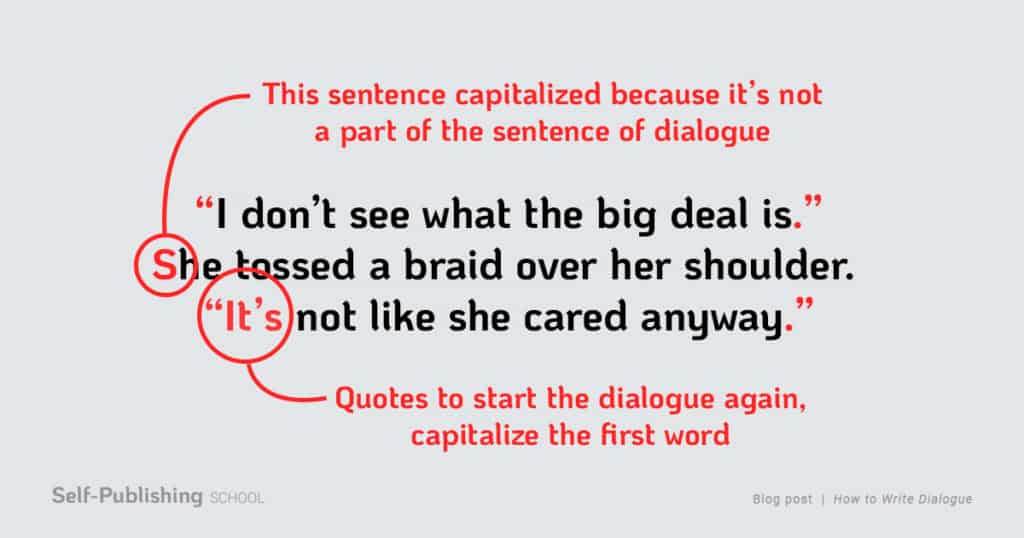
Variation 2:
With this dialogue formatting, it’s different because this is when a character does something while they are speaking, instead of pausing like in variation 1. The action happens in the middle of a sentence and has to be formatted as such.
Example:
“I don’t see what”—she tossed a braid over her shoulder—”the big deal is.”
Here are some dialogue examples of this formatting:
- “It’s really just”—he rubbed his hand over his stubble—”the most frustrating thing I can think of.”
- “If you’re not going to”—she grabbed his face—”at least listen to me, I don’t see the point in even trying.”
You can see the proper formatting for this dialogue below:
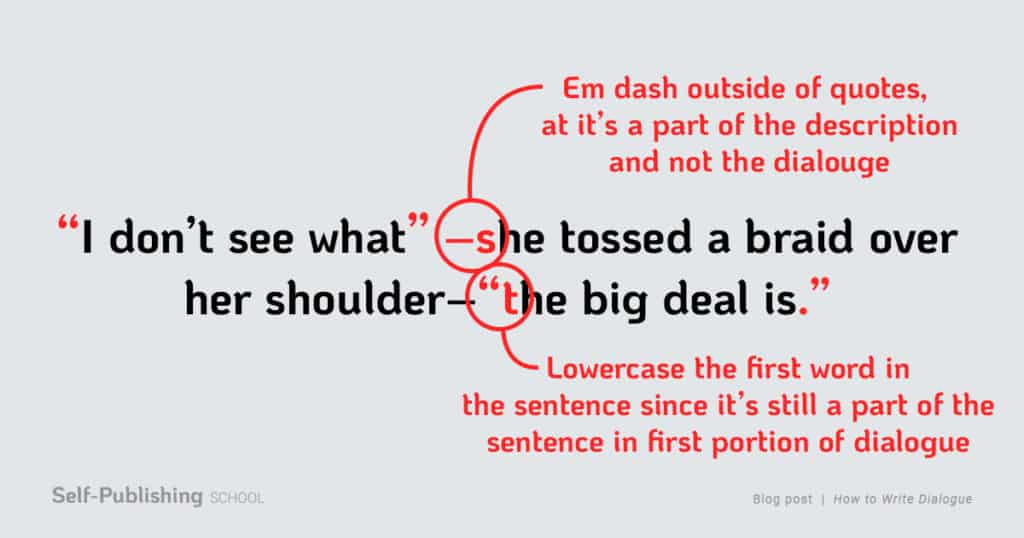
You would use this to help build a clearer image and communicate the scene to match how it is in your head.
This is also the case when characters have inner thoughts within their dialogue, as seen in the second example in variation 2.
Dialogue Example 6: Single line getting cut off
Something that happens in real life (sometimes an irritatingly large amount) is getting cut off or interrupted when you’re speaking.
This typically happens when someone either doesn’t care what you’re talking about or when two people are in an argument and end up speaking over one another.
Example:
“Are you crazy—”
“Do not call me crazy.”
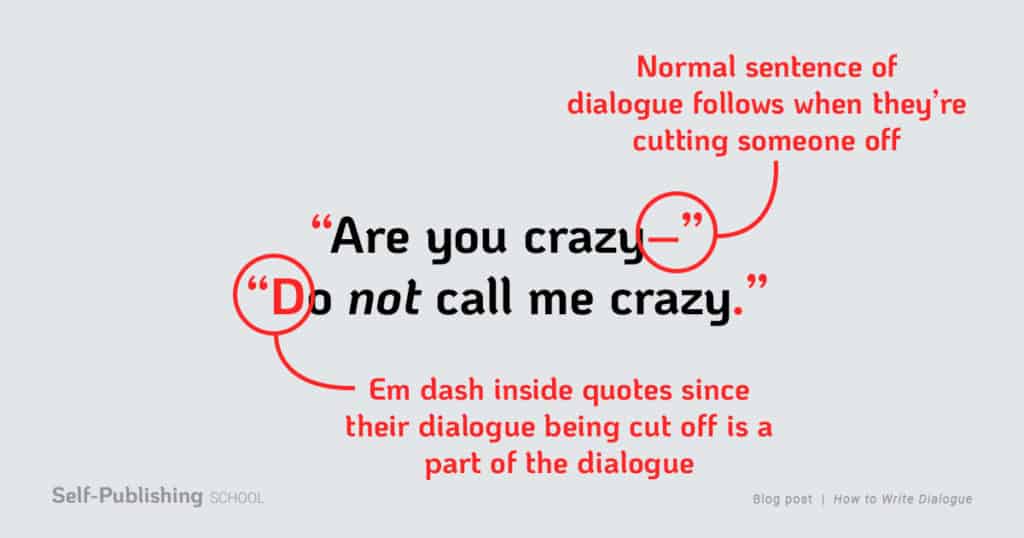
You can see in this example that you place an Em Dash (—) right at the end of the sentence, followed by the quotation marks.
You’ll treat this format of dialogue much like example 1, a single line of dialogue.
Dialogue Example 7: Dialogue tag in the middle of a line
Another common type of dialogue. This is essentially a mix of a single line with a dialogue tag.
Example:
“You really shouldn’t have done that,” she murmured. “That will get you in a lot of trouble.”
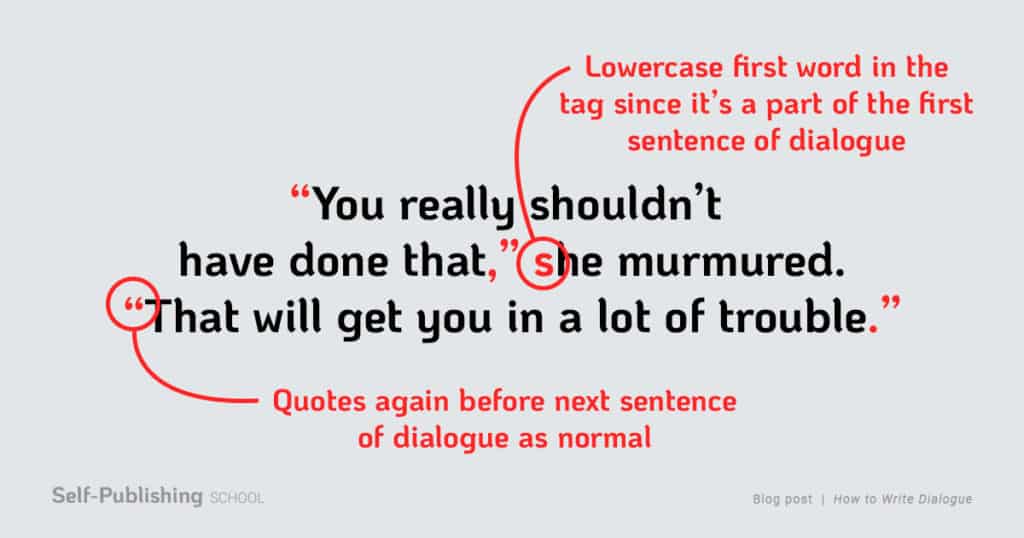
Mostly, you will use this type in order to indicate who is talking if there are more than two and in order to keep the focus on the dialogue itself and not the character’s actions.
Dialogue Example 8: Paragraphs of dialogue
There are certain situations that call for a single character to speak for a long time. However, grammatically, not all of what they say will belong in the same paragraph.
Example: single speaker
“It’s not that I don’t think you should have done that. Not exactly.
“Actually, I think it might be a great thing for you to have done. I’m just worried about what will happen next and how that will impact everyone else.”
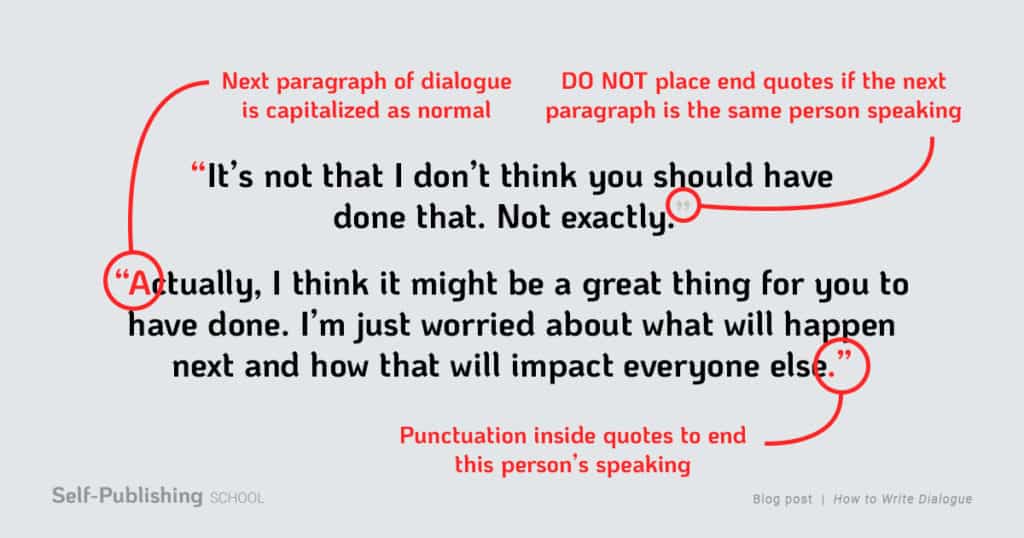
For writing dialogue paragraphs, you want to leave the quotations off the end of the paragraph and begin the next paragraph with them in order to indicate that the same person is just telling a long story.
[NOTE: These dialogue rules apply to American English. Other parts of the world may use different dialogue formatting, including single quotations and more.]
How to Create Dialogue That’s Realistic and Effective
Great dialogue is hard to get right. For something we do and hear every day, knowing what to make your characters say in order to move the plot forward and increase intrigue isn’t easy.
But that’s why we’ve broken it down into easy steps for writing dialogue for you.
Here are some of the best tips for writing dialogue that feels real but is also effective for moving every part of your story forward.
#1 – Say it out loud first
One of the easiest and best ways to see if your dialogue sounds realistic is to read it out loud, especially if you are writing a genre that would benefit from such an approach.
Hearing what someone is supposed to say (since your readers will imagine them speaking out loud) will allow you to determine if it sounds real or fake.
One thing to keep in mind is that sometimes your dialogue will sound a little “cheesy” to you. Since written dialogue is a little different and more purposeful than what we hear in our day-to-day lives, you might think it sounds a little dramatic—and that’s okay. It just can’t be unrealistic.
But that’s okay! Dialogue should have more “weight” than what you say in real life.
Even so, it has to sound like something someone would actually say. If you feel yourself cringing a little or you can’t imagine a real person saying it, you might have to do some editing. A good, creative writer can hear the difference.
Ask these questions when reading your dialogue out loud to yourself:
- Would someone actually say this in real life?
- Does it move the plot forward or develop a character?
- Is it easy to say or do you fumble over the sentence?
- Do you pause in certain areas where you haven’t written commas? (Note: if this happens, put in some commas so the readers interpret it how you hear it!)
Extra dialogue tip: Record yourself reading your dialogue in what you imagine your characters to sound like and play it back to yourself. This can help you pinpoint which words or phrases sound off.
#2 – Get rid of the small talk
Your readers don’t care about what your characters had for dinner last night—unless that dinner had been poisoned and is now seeping into their bloodstream, impacting their immediate danger.
When writing a novel, talking about the weather or your character’s pet or anything trivial will read as boring and unnecessary.
This also slows down your novel’s pacing.
One exception may be if your characters are stalling in order to avoid talking about something that is major and impactful to the plot. When it’s used as a literary device to set the mood or tone of a scene, it’s acceptable.
#3 – Keep it brief and impactful
Dialogue in books is not meant to read in the way we actually speak—not full conversations, at least. If it did, each book would be exceptionally longer, due in part to the fact that humans often say a lot of pointless things.
When it comes to writing dialogue in your book, you have to keep it briefer and more poignant than in real life.
A great way to get to the meat of the dialogue is to cut out everything that doesn’t immediately impact the scene.
A quick, “Hey, how’s it going?” isn’t necessary unless the other character’s state is vital to the scene. This, however, doesn’t include if your character is meeting someone for the first time, obviously. Again, focus on writing the scene in a way that informs the dialogue.
Essentially, anything that does not further develop your character, the plot, or any subplots should be cut.
#4 – Give each character a unique way of speaking
I’m sure you’ve noticed by now, but not everyone speaks in the same way. We all have a specific “flow” to our sentences and we all have favorite words we prefer to use.
This is actually a big part of character development in your novel.
For example, maybe people will use “perhaps” or “maybe” but not often both in equal amounts. This is a very small detail, but it does a long way in developing the characters and giving them their own voice.
Another way you can do this is with sentence structure.
Does your character speak in short, chopped sentences? Or do they eloquently describe their point of view in long-winded, crafted sentences that ebb and flow with their tone of voice?
Do they use a lot of analogies and metaphors when explaining things or is this character extremely literal and gets right to the point?
This difference is very important. Your readers should be able to tell the difference between characters based on their sentences and diction. It ultimately comes down to your chops as an author when it comes to writing styles and your ability to use it to bring your characters alive.
A reasonable exception to this would be pairs or groups of close people. Meaning, if your main character’s best friend speaks similarly to them, that’s okay. As humans, we subconsciously pick up on the speech patterns of those closest to us – those we speak to regularly (like when we use similar slang in our friend group that others may not use).
#5 – Add world-appropriate slang
A major part of the dialogue that often gets overlooked is the slang.
Even in our own world, new slang is developed every day and sometimes, the words might seem crazy or even confusing.
Take the term “fleek” for example. This word looks like it would be a herd of some sort of animal.
But in fact, it’s a word being “on point” or “sharp.”
The point is, creating unique slang for your world can add to the dialogue and tell you more about the characters who use it, not to mention build your world effortlessly.
Here’s an example of slang from Jenna Moreci’s, EVE: The Awakening. This book is set in the near future and so Moreci had to create slang fitting for the time:
#6 – Be consistent with characters’ voices
It wouldn’t make sense for your character to flop the way they speak unless they’re talking to someone specific (which we cover in the next tip).
The main idea is that if one character speaks in choppy sentences, it should remain that way unless the moment changes to something that would require something more elegant.
At the same time, you want to make sure your characters are using consistent language.
Like in the tips in #4, if they use a specific word more frequently, make sure they use that word whenever they should in order to maintain a consistent voice.
#7 – Think about who they’re speaking to
You don’t speak in the same way around every single person.
Your voice and style change depending on who you’re chatting with. For example, you’re going to talk differently to your mom than you would to your best friend.
While it’s important to be consistent with your character’s style and voice, it’s also crucial to think about the who when it comes to their dialogue and adjust accordingly.
#8 – Keep long speech paragraphs to a minimum
Rarely do people speak for a very long time uninterrupted. It might be important for your character to say something lengthy but remember to at least split it up with body language and other means of giving your reader a break.
These can feel very long-winded and end up slowing down the pacing of your book, which can be great if you use them for this purpose.
One way to break up long paragraphs if one person is speaking for a while (like when they’re telling a story of sorts) is to add in the other characters’ body language reactions.
But if you’re trying to move your plot along at a steady rate, avoid long speech paragraphs.
#9 – Cut the hellos and goodbyes
Greetings are absolutely necessary in real life. In your book? Not so much.
Your readers know enough to assume there was a greeting of some sort. In addition, these aren’t usually pivotal parts of your book and therefore, aren’t necessary to have.
An exchange like this will bore your readers to death:
“Hey, Charlie!”
“What’s up, dude?”
“Not much, how are you doing?”
“I’m fine, you know. Same old, same old.”
“Ah, I feel ya. Anything new in your world?”
“Not really, to tell you the truth.”
Cutting these will help speed up your pacing as well as keep the dialogue to the must-speak information.
#10 – Show who your character is
One of the best methods of character development is dialogue.
Think about it: how do we learn about new people when we meet them? Through what they say.
You could meet someone entirely new and based on the exchange, you actually learn a lot about who they are and how they operate in life.
You discover if they’re shy, bold, blunt, or kind-hearted and soft-spoken.
Your dialogue should do the very same for your characters.
Here’s an example of what this would look like:
She let stray strands fall in front of her face as she looked down and scuffed something sticky on the sidewalk.“Do you really think so?” Her voice was soft, her eyes still fixed on the ground instead of the new guy standing in front of her.
This example shows you what the character looks like in a specific situation and therefore, we gather facts about what she’s like.
For one, she’s shy—as much is seen by her avoiding eye contact even as she speaks.
Common Dialogue Mistakes to Avoid
We all make mistakes. But if you want to become a published author (or just write a great book), you can’t make these major ones within your book’s dialogue.
#1 – Using the person’s name repeatedly
It’s tempting to make your characters call each other’s names often. However, this isn’t how we talk in real life.
Unless we’re trying to get their attention or are emphasizing (or warning!) a point, we don’t say their name.
How not to write dialogue:
“Rebecca, I really needed you and you weren’t there.”
“I’m sorry, Ashley. I was just busy with school and work.”
“Okay, but that’s not a good excuse Rebecca.”
“You’re right, Ashley. It’s not.”
#2 – Info-dumping through dialogue
It’s perfectly okay to have some characters explain certain elements your readers won’t understand. However, it gets very boring and unrealistic when that’s all they do.
Your world should unfold gradually to the reader through showing and not telling.
In the case of dialogue, this worldbuilding is all “tell” and no show. And this works sometimes, especially if a character is telling another character about something they don’t yet know.
Just keep this to a minimum and use other methods of worldbuilding to show your readers the world you’ve created.
#3 – Avoid repetitive dialogue tags
There’s nothing quite as annoying as reading dialogue tags over and over…and over again.
It’s a surefire way to bore your readers and make them want to set the book down with no plans to pick it back up in the immediate future.
How not to write dialogue with tags:
“I really needed you and you weren’t there,” Ashley said.
“I’m sorry. I was just busy with school and work,” Rebecca replied.
“Okay, but that’s not a good excuse,” she huffed.
“You’re right. It’s not,” Rebecca whispered.
#4 – Avoid repetitive dialogue styles
This means that if you have the same dialogue format for a few lines, you need to change it up because otherwise, it will be very boring to your readers.
You can see in the point above, using only dialogue tags at the end is very boring. The same applies for repeated other types as well.
For example, read through each of these and you can get a feel for the monotony you want to avoid within the repeated formats.
Bad Dialogue Example 1: Dialogue tags in the front
He spoke. “You’re one of the oddest people I know.”
She replied, “Is that necessarily a bad thing?”
He smiled. “I didn’t say it was a bad thing at all.”
She laughed. “Good.”
Bad Dialogue Example 2: Action within the dialogue
“I’m just not sure”—she grabbed a handful of seeds— “that you’re taking this seriously.”
“What?” He weaved between the overgrown plants, pushing them aside. “Why would you think that?”
“Because you—” she plunged her finger into the pot with soil— “just ignore the important stuff unless it’s important to you only.”
“That’s ridiculous.” He craned his neck around a calla lily. “That’s not true.”
Bad Dialogue Example 3: Tags in the middle
“I really wish you would just talk to me,” Ada said. “This silent treatment isn’t helping anyone.”
“It’s helping me,” he said. “Or does that not matter to you?”
“Of course it matters to me,” she replied. “It’s just not solving the problem.”
“I don’t think anything can solve this problem,” he murmured. “It’s permanent.”
How to fix this: whenever you’re writing dialogue, switch the type of formatting you use in order to make it look and sound better. The more enjoyable it is to read, the more readers will become invested.
One exception is when you have two characters going back and forth very quickly. In this case, a few lines of dialogue only, with no tags or anything, is acceptable.
Fixing Dialogue Example: Variation is Key
“I’m just not sure”—she grabbed a handful of seeds— “that you’re taking this seriously.”
He weaved between the overgrown plants, pushing them aside.“Why would you think that?”
“Because…you just ignore the important stuff unless it’s important to you only.”
“That’s ridiculous.”
“No.” She plunged her finger into the pot with soil, dropping in a few seeds. “It’s true.”
Much like with anything that has rules, there are always exceptions.
The most important part of these rules is knowing them.
Once you know the rules and why they’re there, you can break with purpose – instead of doing so on accident.
Want To Learn More About Self-Publishing School and our Book Coaches and Book-Writing Courses?
If you have additional questions or need additional resources, book a call with our Resource Team.
Our team can give you extra resources to help you on your author journey, learn about your book and your book goals.
If you’re interested in learning more about how Self-Publishing School can help you write, publish, and market your books (or sell more books if you’re published already), our Resource Team can also schedule a call with one of our Publishing Success Strategists for you.
Your Success Strategist will ask questions about your book to understand if you’re a good fit for our programs and explain what we offer at Self-Publishing School. You’ll learn about our tailored courses, writing groups, mastermind community, and our amazing book coaches.
With one of the highest success rates in the industry (for an online school plus coaching and accountability program), we want to make sure that you are paired with the right coach and program for your book, or we’ll recommend other resources for you.
Curious, but not ready to book a call yet? No problem!
Grab a copy of Published. below to get the definitive guide on “how to write a book” PLUS get access to the audiobook, advanced trainings, and additional resources to help you write your book!
Happy writing!


Book Outline Generator
Choose your Fiction or Nonfiction book type below to get your free chapter by chapter outline!
Book Outline Generator
Enter your details below and get your pre-formatted outline in your inbox and start writing today!
CONGRATULATIONS
Thanks for submitting! Check your email for your book outline template.
In the meantime, check out our Book Outline Challenge.
